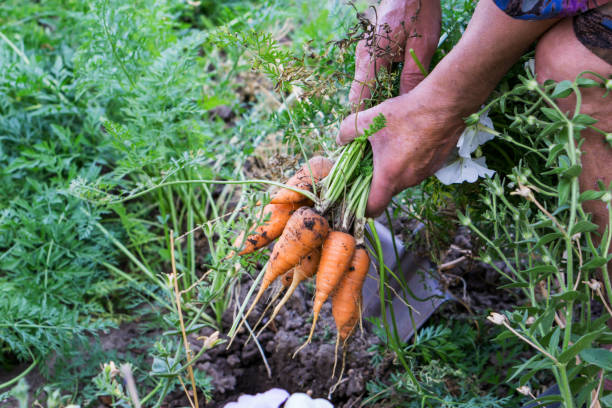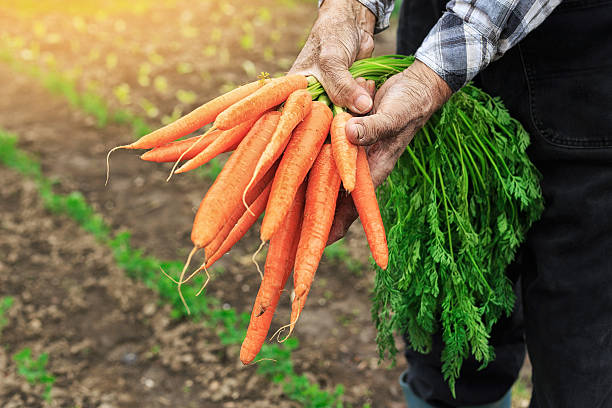
Welcome to our comprehensive guide on successfully growing and caring for carrots (Daucus carota). Carrots can be a bit challenging to cultivate, as their growth occurs primarily beneath the soil, making it difficult to gauge their progress. However, with the proper techniques and knowledge, you can succeed in growing your own delicious and vibrant carrots. This guide will provide valuable insights and tips to help you cultivate healthy carrot plants and harvest a bountiful crop. Let’s get started!
Understanding Carrots
Carrots are biennial vegetables, typically harvested in their first year of growth before overwintering and setting flowers in the following year. They have finely dissected foliage with fern-like compound leaves and produce flowers with five petals and sepals arranged in compound umbels. While carrots are best known for their long, orange roots, they come in various colors and shapes, offering your garden a delightful array of options.
Planting Carrots

When to Plant
Carrots thrive in excellent weather conditions. You can begin planting carrot seedlings or sowing carrot seeds as soon as the soil becomes workable in the spring, even two to three weeks before the last frost. Consider succession planting carrots every few weeks throughout the spring for a continuous harvest. Growing carrots in the fall and winter can yield favorable results in warmer climates.
Selecting a Site
Choosing the right site is crucial for the successful growth of carrots. Opt for a spot that receives full sun for six to eight hours daily, with a bit of shade in the late afternoon. The soil should be loose, sandy, and well-draining, as carrots tend to develop rough roots when forced to grow in heavy soil. Creating raised beds with loose soil provides an ideal environment for carrot cultivation.
Spacing, Depth, and Support
Proper spacing is critical to achieving a healthy carrot crop, although it requires diligent thinning. Plant the seeds evenly, approximately 1/4 inch below the soil surface and about two to three inches apart. While seedlings can tolerate sprouting 1/2 inch apart, they typically require three inches of space as they grow. It is best to snip or pinch the excess seedlings at the soil line to avoid damaging nearby roots. Carrots generally do not require support but are sensitive to transplanting and disturbance.
Carrot Care

Light
Although the carrot roots grow underground, the foliage requires full sun to partial shade to facilitate the rapid growth and development of the roots, allowing them to acquire their natural sweetness.
Soil
Loose and well-draining soil is essential for healthy carrot growth. Rocks and clumps in the soil can cause the roots to split and become deformed. Carrots prefer slightly acidic soil, with a pH range of 6.0 to 6.8.
Water
Provide your carrots with at least one inch of water per week. Mulching around the plants helps conserve moisture and keeps the soil cool, promoting optimal growth.
Temperature and Humidity
While carrots are typically grown as annuals in all zones and climates, they thrive best when nighttime temperatures average around 55 degrees Fahrenheit, and daytime temperatures average 75 degrees Fahrenheit. Carrots can be planted in warmer regions as a late fall and winter crop.
Fertilizer
If your soil lacks organic matter, supplemental feeding will be necessary approximately two weeks after the carrot tops emerge. Any high-quality organic vegetable fertilizer will suffice. However, it is essential not to overuse nitrogen fertilizer, as it primarily promotes foliage growth, which is undesirable for root development.
Types of Carrots
Carrots come in diverse varieties, boasting various sizes and colors. Here are some unusual carrot varieties you can consider growing:
- ‘Danvers Half Long’: An early, sweet combination that is easy to grow.
- ‘Imperator’: A long variety that retains its sweetness and crunch even in storage.
- ‘Little Finger’: A sweet three-inch baby carrot, perfect for snacks and salads.
- ‘Paris Market’/’Thumbelina’: Plump, round, and bite-sized, offering a unique aesthetic to your harvest.
Carrots vs. Parsnips
Carrots are often mistaken for parsnips due to their similar appearance. In fact, many carrot and parsnip varieties share the same color and shape. However, carrots (Daucus carota) and parsnips (Pastinaca sativa) differ in taste, with carrots offering a sweet flavor and parsnips providing a spicy bite. Both vegetables belong to the same family and are frequently used together in recipes to enhance the overall flavor profile.
Harvesting Carrots

Growing carrots can be a bit of a gamble, as you cannot assess their progress until harvest time. The harvest timing depends on the variety you are growing, with an average maturity period ranging from 50 to 75 days from seed.
To determine if your carrots are ready for harvest, examine the tops of the plants to ensure they have filled out to the expected diameter. However, the most accurate test is to lift one of the carrots and taste it. Harvesting prematurely may result in a lack of sweetness while allowing them to mature fully, sometimes even after a frost, enhancing their flavor.
To harvest carrots, gently twist and pull them from the soil if the ground is soft enough. If the soil is compacted, it is advisable to loosen it slightly before harvesting to avoid damaging the carrots. After harvesting, remove the leaves immediately, as they continue to draw energy and moisture from the roots, potentially diminishing the sweetness of the carrots.
Growing Carrots in Pots

If loose, well-draining soil is not readily available in your garden, growing carrots in pots can be a viable alternative. Carrots require specific conditions to grow properly without forking or deforming. Here’s how you can successfully grow carrots in pots:
- Select a container with a diameter of at least 12 to 24 inches and a depth of 12 inches, ensuring it has ample drainage holes.
- Fill the container with potting soil formulated explicitly for potted vegetables. This type of soil provides the necessary loose texture for optimal carrot growth.
- Choose shorter finger-type or small round carrot varieties, such as ‘Paris Market,’ as they are well-suited for container cultivation.
- Water the container deeply once a week, as potted carrots require more frequent watering than those grown in the ground.
Pruning Carrots
To prevent deformed roots, keeping the carrot growing area free of weeds is essential. Thinning the carrot plants during their growth is necessary to provide sufficient space for each carrot to develop properly. You can use the thinned baby carrots in salads, ensuring that the remaining carrots are adequately spaced to avoid overcrowding when they reach maturity.
Planting Carrots from Seed
While carrot seedlings are available for purchase, sowing carrot seeds directly into the garden is the most common cultivation method. However, due to the tiny size of carrot seeds, achieving even spacing can be challenging. Here’s how you can successfully plant carrots from seed:
- Prepare the soil by tilling it to a depth of at least one foot, ensuring it is light, loose, and well-draining.
- If you plan to sow multiple rows, create shallow furrows in the soil, approximately 1/4 inch deep and one foot apart.
- Sprinkle the tiny carrot seeds evenly, keeping them two to three inches apart and 1/4 inch deep. As carrot seeds are challenging to space evenly, thinning will likely be required as they grow.
- Use a plastic row marker, paint stick, or popsicle stick to label the rows with the crop name and the sowing date. This will help you identify and care for the planted rows effectively.
- Gently press down on the soil to ensure good seed-to-soil contact.
- Keep the furrows consistently moist to prevent the soil from drying out and forming a hard crust that can impede seedling emergence.
- Provide the seedlings with approximately one inch of water per week.
- When the seedlings reach one to two inches, thin them out to maintain a spacing of three inches between each carrot. Use scissors or snips to avoid damaging nearby developing roots.
Overwintering Carrots
If you wish to leave your carrot plants in the ground during the winter, thorough weeding before the first frost is essential. Applying a three-inch layer of straw or fallen leaves as heavy mulch can protect the carrots from extreme cold. Consider using a fabric row cover to shield the plants in regions with particularly harsh winters. Although the tops of the carrots may die during this period, the roots will continue to store sugar to survive. Harvest these overwintered carrots before early spring, as they may start to form flowers beyond that point.
Common Pests and Plant Diseases

The most significant pest that affects carrots is the carrot rust fly. This fly lays its eggs in the soil near the carrot tops. Upon hatching, the larvae burrow into the soil and feed on the carrot roots, creating tunnels and causing damage. Carrot weevils can also inflict similar harm. Consider rotating your carrot planting location each year to protect your crop from these pests. Additionally, using row covers made of garden fabric can provide adequate protection.
Nematodes, microscopic worms, can become a problem later in the season, leading to badly deformed carrot roots. Solarization, a process involving soil heating, can help eliminate nematodes. If nematodes persist in a particular area, rotating to a different crop and planting carrots elsewhere is advisable.
While carrots remain hidden below the soil surface, their foliage attracts various animals that may consume the tops or dig into the soil. Deer, groundhogs, rabbits, and opossums are just a few examples of pests that can damage your carrot crop. Erecting fencing around the garden is the most effective deterring these animals.
Several leaf spot and bacterial diseases can affect carrots, including Alternaria leaf blight, carrot yellows, and bacterial soft rot. Once the plants are infected, there are limited treatment options available. Regular monitoring and prompt removal of any diseased plants are essential practices. Cleaning up all garden debris at the end of the season and rotating your carrots to a different area each year can help prevent the persistence of harmful microorganisms in the soil.
Frequently Asked Questions (FAQ)
Are carrots easy to grow?
While even experienced gardeners can face challenges when growing carrots, producing long and sweet roots with the right conditions is possible. Loose soil, cool weather, and consistent watering are critical for cultivating sweet and crunchy carrots.
What is a good companion plant for carrots?
To prevent soil crusting and facilitate the sprouting of carrot seeds, consider planting radishes alongside your carrots. Radishes sprout quickly and help loosen the soil, creating an ideal environment for carrot germination.
Can you grow carrots in water?
Carrots are taproot vegetables and cannot regrow themselves from water alone. However, an interesting project for children involves placing the top stump of a carrot in a glass of water, supported by toothpicks, similar to growing an avocado pit. Although the roots will develop in the water, this is primarily a fun experiment rather than a practical method of growing carrots for consumption.
Conclusion
Congratulations! You have now gained valuable insights into successfully growing and caring for carrots. By following the guidelines and tips in this comprehensive guide, you will be well-equipped to cultivate your vibrant and delicious carrot crop. Remember to choose a suitable site, ensure proper spacing, provide adequate sunlight and moisture, and protect your plants from pests and diseases. With patience and dedication, you will soon be enjoying the rewards of your labor—a bountiful harvest of sweet, homegrown carrots. Happy gardening!






